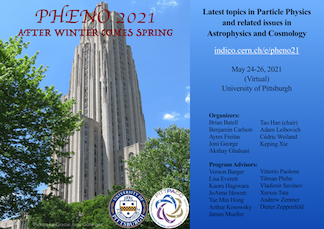Speaker
Description
We propose a $SU(5) \times U(1)_X \times U(1)_{PQ}$ model, where $U(1)_X$ is the generalization of the $B-L$ (baryon minus lepton number) gauge symmetry and $U(1)_{PQ}$ is the global Peccei-Quinn (PQ) symmetry. There are four fermions families in $\bf{{\overline 5}} + \bf{10}$ representations of $SU(5)$, a mirror family in $\bf{5}+\bf{{\overline {10}}}$ representations, and three $SU(5)$ singlet Majorana fermions. The $U(1)_X$ related anomalies all cancel in the presence of the Majorana neutrinos. The $SU(5)$ symmetry is broken at $M_{GUT} \simeq (4-7)\times 10^{15}$ GeV and the proton lifetime $\tau_p$ is estimated to be well within the expected sensitivity of the future Hyper-Kamiokande experiment, $\tau_p \lesssim 1.3 \times 10^{35}$ years. The $SU(5)$ breaking also triggers the breaking of the PQ symmetry, resulting in axion dark matter (DM), with the axion decay constant $f_a$ of order $M_{GUT}$ or somewhat larger. The CASPEr experiment can search for such axion DM candidates. With the identification of the $U(1)_X$ breaking Higgs field with the inflaton field, we implement low scale inflection-point inflation with $H_{inf} < 10^9 $ GeV which successfully resolve the cosmologically fatal axion domain wall, axion DM isocurvature and $SU(5)$ monopole problems. The vectorlike fermions in the model are essential for achieving a successful unification of the SM gauge couplings as well as the phenomenological viability of both axion DM and inflation scenario.

